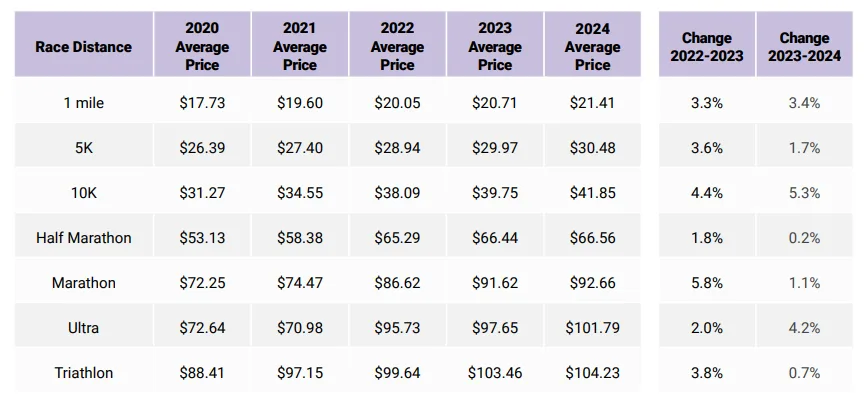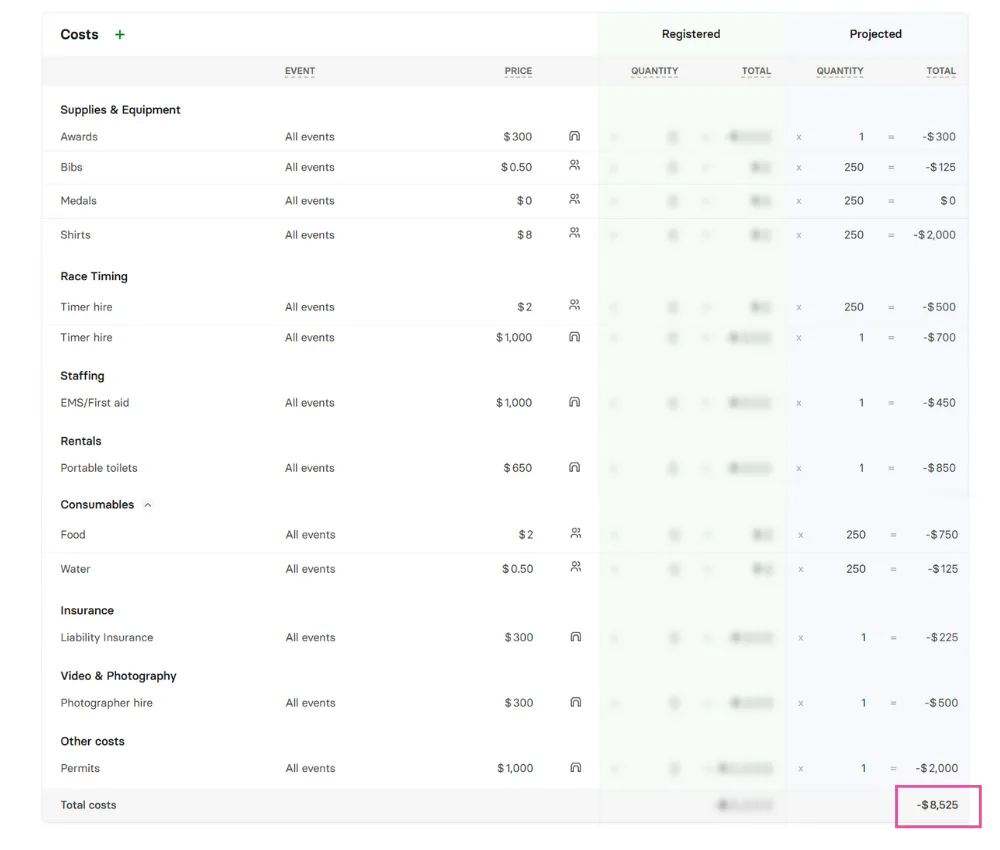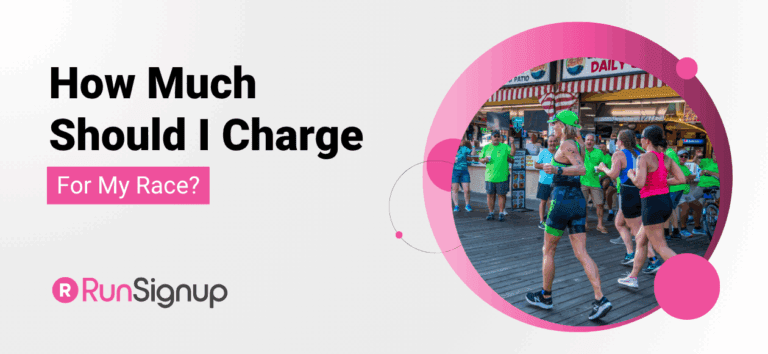Every race director wants to know the magic price that strikes the perfect balance between participation and revenue. Unfortunately, there is no simple formula that tells you what your race should cost. And, with rising prices over the last few years, the pricing target can feel like it’s constantly moving.
However, we do have data that can help you to determine the best pricing for your race.
Pricing Example: The Fictional 5K
To better illustrate the process of pricing a race, we will be pricing The Fictional 5K, to be “held” in Philadelphia, PA on 11/1/2025. To price this (fictional) race, we will use the following steps:
Understanding Average Prices
The first step to pricing your race is to get an idea what an average race costs. There are a number of variables that make a difference, and you’ll want to weigh each one.
Average Prices by Distance
Distance is a major factor in how much a race typically costs. In general, the longer the distance, the higher the overhead for things like road closures, timing staff, and permitting. RunSignup publishes the average prices by distance annually in our RaceTrends Report. In 2024, the average prices by distance were as shown below:
Average Race Price by Distance

These prices are just averages – many races start at a lower price and end at a higher price (we’ll discuss price increases below). And, there are many reasons a race might be more or less expensive than the average, such as offering premium swag (higher price) or being hosted on private land with no permitting costs (lower price). But in general, if you’re hosting a 5K, you don’t want your average price to be $70 or $5 when the average national cost is $30.48.
Additionally, you want to understand the general trend of prices. While we don’t yet have pricing data for 2025, we do know that 5K prices increased 3.6% from 2022-2023, and another 1.7% from 2023-2024. It’s reasonable to expect 2025 prices will be at least 2-3% higher, again, or closer to $31.25.
Fictional 5K Status Update:
Based on the national averages and the expectation of continued price increases, we want to price our race with an average price slightly above last year’s average.
Current price: $31.50
Local Race Prices
The caveat to average prices by distance is that race prices also vary widely by location. There can be regional differences, but prices may be higher in a specific city because of high permitting costs, or low in a town that hopes to bring special events to their community. Unfortunately, because location-based factors are precise, there is no simple report telling every race director what races in their area typically cost. But you can (and should) do research to understand typical costs in your area.
To get average prices in your area, use a race calendar like RunSignup.com/races or RunningInTheUSA.com. This process can be tedious, though, so we typically recommend calling on some AI assistance. Instead of manually opening every race, ask ChatGPT to use the RunSignup race calendar to look for races in your area and distance and report on their costs. Advice:
- Be specific. Indicate if you want road or trail races (or both), the distance of the race, the radius of the area, the time range you’re looking for, and whether you want processing fees included.
- If you live in a more remote area, you may need to widen your area, include other communities like yours, or increase your time range to look at more events.
- The output likely won’t be perfect. In our example, ChatGPT couldn’t find a price for one race because they did not have event tiles with pricing on their RunSignup page. You may still need to do a little manual research to find the data you need.
Prices of Upcoming Races in Philadelphia

Fictional 5K Status Update:
After manually adding the prices for the Philadelphia Distance Run ($25 early; $75 late) and ignoring the free race, the average price for a 5K in Philadelphia is $41.67, notably higher than the national average. However, I also want to take into account that the highest priced race here is hosted by the local MLB team and likely has a higher production cost and more demand than my local 5K. With all of that, I want my average cost to land somewhere between the national average and the Philadelphia average.
Current Price: Between $30-$40.
Adjusting Your Race Price Based On Your Budgeted Costs
It’s helpful to know what other races cost, but at the end of the day, your race price has to meet your needs. Most races won’t make any notable revenue from registrations (that comes from sponsors and fundraising). However, you likely want to (at least) break even.
To do this, make a budget with all your estimated fixed and per-runner costs. Don’t forget to include any revenue you need for your own salary, etc. Then, make a (realistic) estimate of how many runners you can expect. Finally, use the total costs of your event to determine the per-runner cost. If possible build in a little cushion.
You can use excel for your budget, but there are also some good tools budgeting tools, like Race Directors HQ’s budget building tool. You will have to add a registration price at the beginning, but you can adjust that after you finalize your decision. For this step, focus on costs, not revenue. You can see that the builder lets you add fixed costs (one for the whole race) and per-runner (based on your estimated turnout).
Sample Race Budget

Fictional 5K Status Update:
The Fictional 5K has an estimated turnout of 250 participants and an estimated cost of $8,525. That means I expect the race to cost $34.10 per-person. I’m working on sponsorships to generate revenue, but need to at least break even on registration prices. Because of that, the average price will be set on the high end of my $30-40 range.
Current Price: $40
Deciding When To Have Price Increases (And For How Much)
We have now determined what we need our average runner to pay. However, many races increase the price throughout the registration lifecycle. This allows you appeal to more budget-conscious runners (they can register early) while capitalizing on procrastination with a premium price for late registrations. Perhaps most importantly, price increases are an opportunity for marketing and a strong call to action. 25% of all registrations come in within 3 days of a price increase.
How many price increases you should have and how big of a gap there is between the high and low prices is somewhat dependent on the race distance and details. There are exceptions, but general, the longer the race the longer registration is open and the more price increases.
How Many Price Increases Should You Have?
Step one is to decide how many price increases you want, and how large the increases should be. We have a little data to start with here.
Average # of Price Increases per Race

As you can see, the average 5K has just one price increase. However, deviating from the data a little, our RunSignup recommendation is that price increases are under-utilized and most races could benefit from adding more. To help determine what makes sense, we also have data on when people register, by distance. From this you can get an idea how long a typical registration lifecycle is for your distance, and when you have the opportunity for registration spikes.
When Runners Register by Distance

Visually, you can see the natural pattern of registrations, with an initial jump, a mid-cycle spike, and a late rush. However, the timing of those spikes varies widely by distance. Below, you can see the actual percentages associated with each spike.

Generally, we would recommend at least 2 price increase for a 5K. One would be mid-cycle to motivate some of those who typically register 15-30 days our to sign up a little earlier, before your ordering deadlines. The second one would come before race week to discourage waiting until race day. Remember, price increases are largely about motivating people to take action.
What’s The Difference Between My High and Low Price?
Finally, decide how large of a difference there is between your minimum and maximum price. For a 5K, the difference between the minimum and maximum price is $10.13. In other words, if you’re following the average 5K price of $30.48, you would expect the early bird registration cost to be around $25.48 and late registration to cost $35.48.

Fictional 5K Status Update:
I want to take advantage of the power of price increases, so I will have 2 increases. First, I’ll reward the early registrants with a cost that just covers our costs. Then, I’ll increase to a price with a little more buffer one month before race day to beat our ordering deadline. Finally, I’ll have race week registrants pay a premium.
Current Pricing: Early Bird Registration (until 1-month out): $35, Regular Registration (4 weeks to 1 week out) : $40, Late Registration (race week): $45
Incorporating Discounts
The final thing to take into account are any additional discounts you plan to offer.
While pricing can motivate action, it’s important not to over-discount your race. First, you want to make sure that you’re never offering a late discount that’s less than your early-bird pricing – otherwise, you’re actually punishing people for registering early. Second, you want your pricing to be easy to understand. If people need a calculator and a piece of paper to figure out the optimal date and time to register, the power of pricing is lost.
Discounting Options:
- Coupon Codes to share a discount code for specific groups or throughout a dedicated time.
- Age-Based Discounts to discount by age (typically for kids and/or seniors).
- Multi-Person Discounts to discount registration when multiple people sign up together.
- Club Membership Discount to discount members of a specific club (or clubs).
- Group/Team Discounts to discount members of a group/team if the group reaches a pre-determined size.
- Reserved Entry Links to offer discounted registration that is tied to a specific person (and not sharable).
- Referral Rewards to refund participants who successfully refer additional people to sign up.
- Multi-Race Bundles to discount race registration when a registrant signs up for more than one of your races at once.
Fictional 5K Status Update:
I want to pick 2 types of discounts for my race. First, I want the event to be family-friendly, so I’m going to offer an age-based discount that reduces the cost for kids under 18 by $10. Second, since it’s a new race I want to encourage people to invite their friends. I’m going to offer a group/team discount that reduces registration by $5 for members of any team that exceeds 5 people.
Final Pricing:
| Early Bird Registration (until 1-month out) | Regular Registration (4 weeks to 1 week out) | Late Registration (Race Week) | |
| Adult Registration | $35 | $40 | $45 |
| Under-18 Registration | $30 | $35 | $40 |
Invite your friends: if your team reaches 5 or more members all members get a $5 refund!
Optimizing Your Pricing Every Year
Congratulations! You are done pricing your race. But you’re not really done. Pricing is something you should re-evaluate every year. Each year, you want to re-run the pricing steps to account for changes:
- Review averages: have the national and/or local race prices shifted?
- Budget: did you meet your financial goals last year? If your anticipated total number of participants is different this year, how will that impact your budget?
- Price Increases: should you adjust your schedule of price increases? Consider adding an additional price increase, or increasing the cost of a later registration.
- Discounts: were the discounts offered last year successful at prompting registrations?
Reminder: Your Race Price May Be Different
Remember, the Fictional 5K priced out here is exactly that: fictional. Your 5K pricing may look very different if you have higher (or lower) costs, different local pricing expectations, or more (or fewer) runners.
